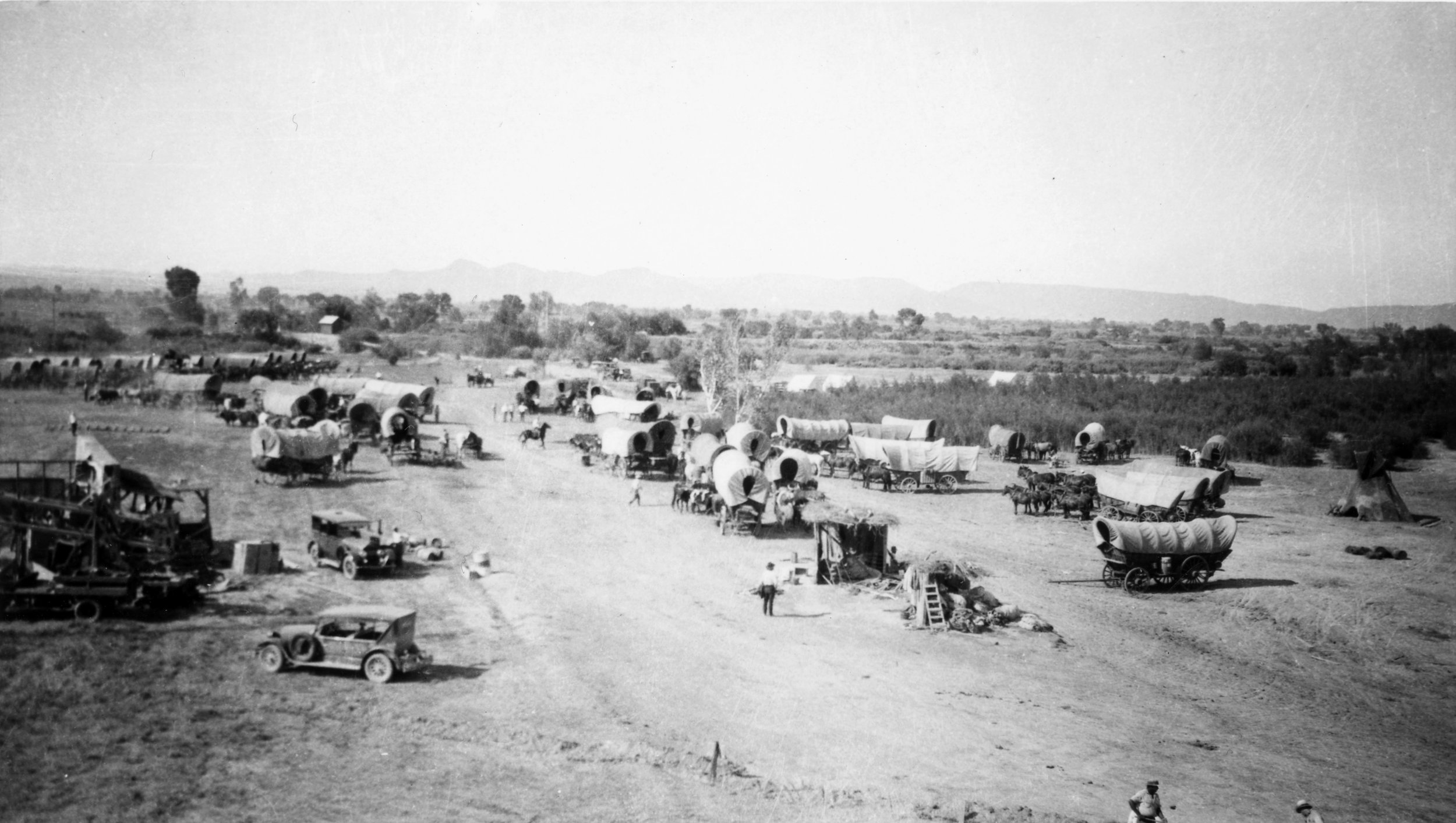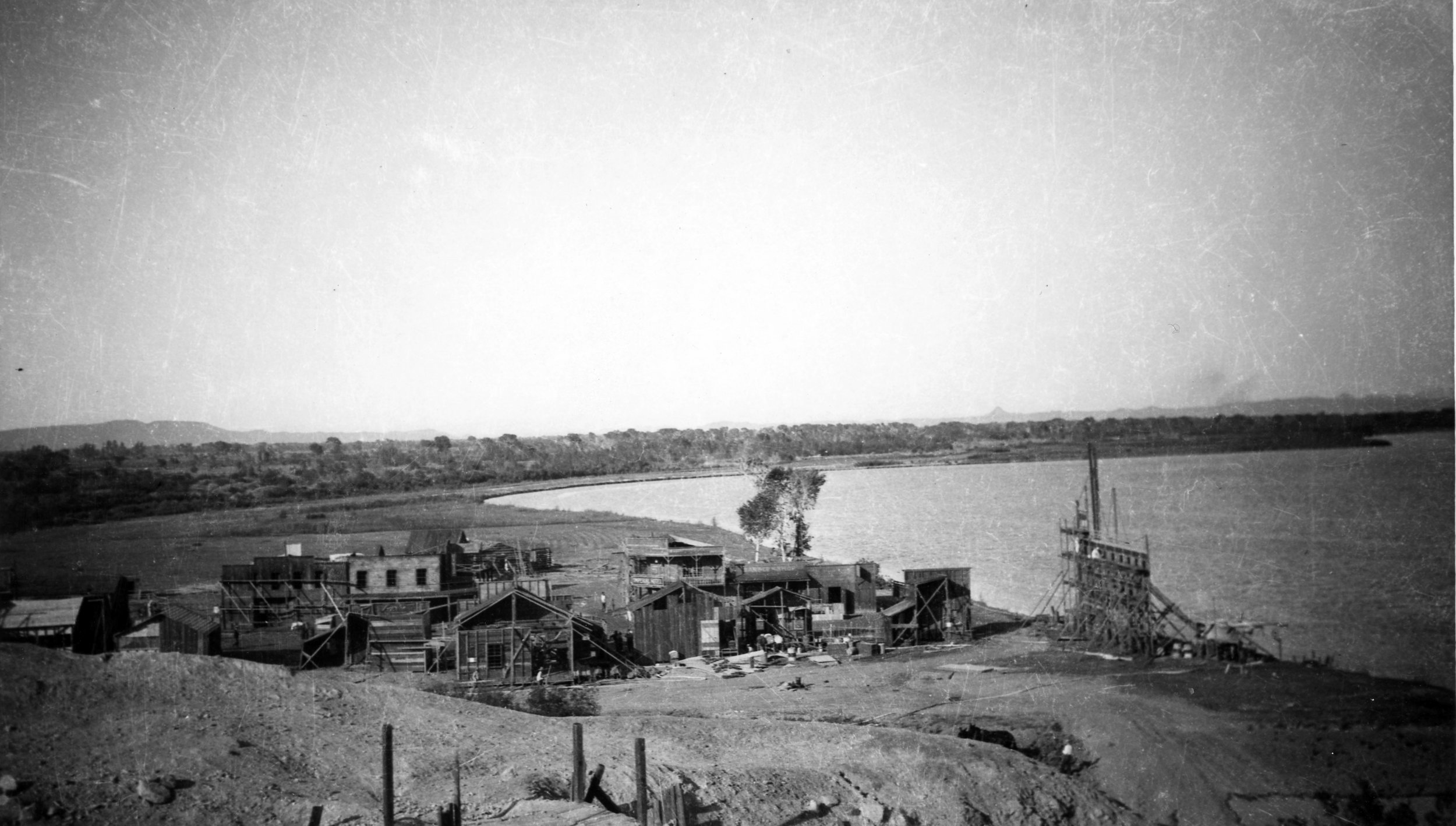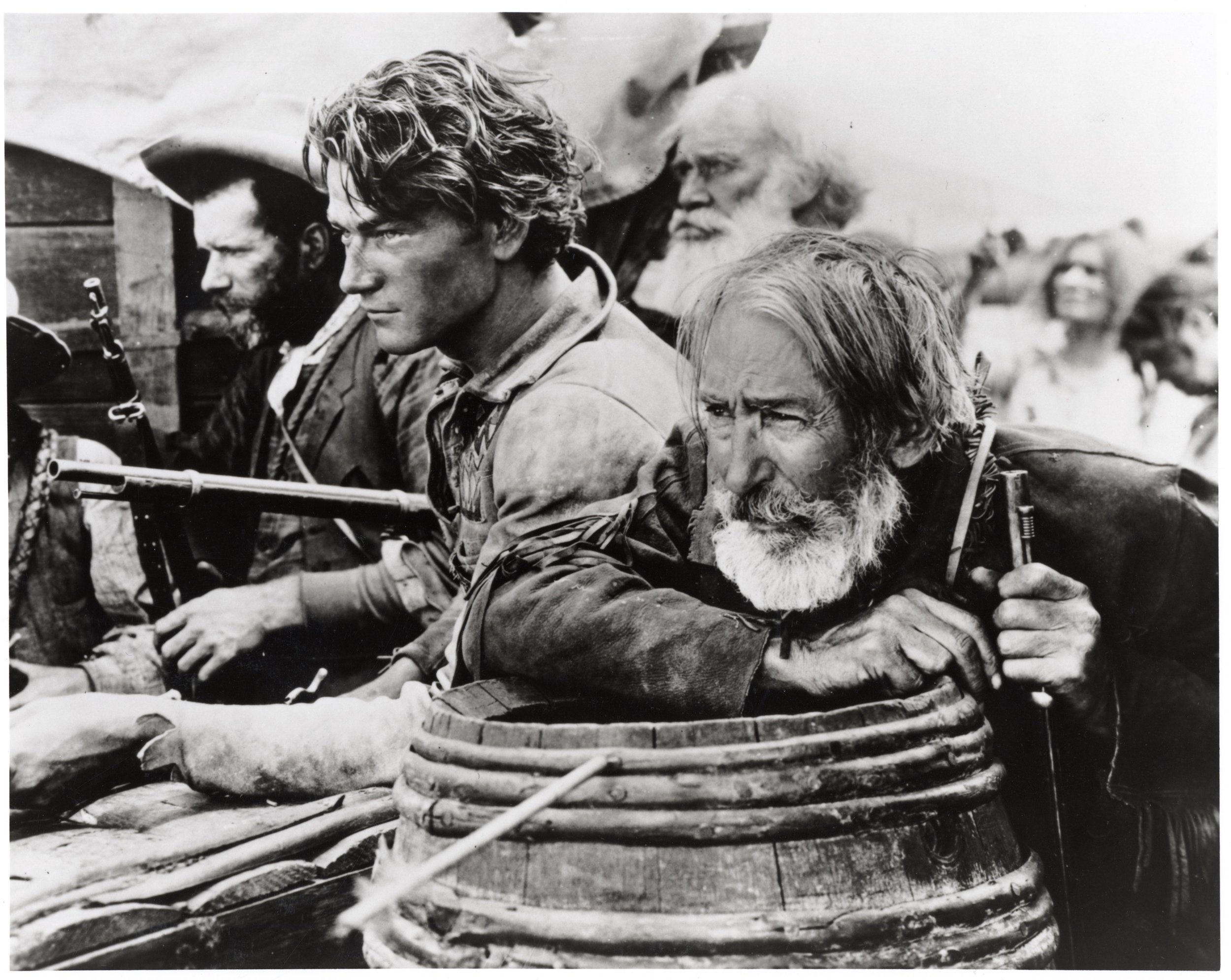A behind-the-scenes shot from The Big Trail (1930) set in Yuma, Arizona. Photo courtesy of Mrs. Hazel Balinger from The Lapidary Journal.
Written by Jason Apuzzo
In August of 1927, a little-known USC football player named Marion Morrison—nicknamed “Duke” by his friends—announced to his disappointed father that he was dropping out of college. Just over three years later, this same young man’s name would be emblazoned across the front of Hollywood’s Chinese Theatre, where his first major film, an epic Western, would premiere in a new 70mm film process set to revolutionize the motion picture industry. The name outside the theater, however, was no longer Marion Morrison. It was John Wayne.The improbable, overnight transformation of Duke Morrison into John Wayne is the stuff that Hollywood dreams are made of, especially considering that the young man wasn’t even a professional actor at the time. And it all began with a larger-than-life film calledThe Big Trail.
In late summer of 1929, young Duke Morrison was a busy prop hand working at Fox Studios. A handsome, hardworking ex-Boy Scout from a modest Glendale family, Duke had recently lost his USC football scholarship due to a shoulder injury sustained while bodysurfing off of Newport Beach. His professional prospects at the time were limited. Although taken under the wing of director John Ford while at Fox, Duke’s work at the studio was mostly restricted to swing gang gigs, lugging furniture and building sets. Occasional stints as a bit player in Ford’s films enlivened things, as did stunt work, but Duke’s future seemed uncertain. And if Ford had any intention of developing young Duke as acting talent, he certainly didn’t bother to communicate it to his protégé. Making matters worse, financial woes were forcingDuke to abandon his initial hope of a legal career. This, in turn, was delaying his ability to marry the beautiful young socialite Josephine Saenz—the girl of his dreams.
Into this messy situation stepped Raoul Walsh. The legendary director had big plans for a new film calledThe Big Trail, which was based on a Saturday Evening Post serial by Hal Evarts. The film was designed to commemorate the centennial of the Oregon Trail by depicting in realistic detail the westward migration of America’s early pioneers. Indeed, the Fox film was set to be the most elaborate western production ever, featuring 20,000 extras, 1800 cattle, 1400 horses and even 500 buffalo. The film would be shot in seven different states and boast five separate casts—one each for the English, Spanish, Italian, French and German versions of the film. Plus, The Big Trailwould be shot not only in conventional 35mm, but also in the new 70mm Fox Grandeur widescreen format. Everything about The Big Trail was going to be not just big, but massive.
To front such a huge production, Walsh had wanted either Tom Mix or Gary Cooper for The Big Trail’s lead role of trail scout Breck Coleman, but neither star was available. That was when Walsh noticed a certain young prop hand hauling furniture across the set of Ford’s Born Reckless. Young Duke “had a western hang to his shoulders and a way of holding himself and moving which is typical of a westerner,” Walsh would later say. “I noticed the fine physique of the boy, his careless strength, the grace of his movements.” An extensive audition process—which included acting and voice lessons, as well as training in horseback riding and knife throwing—convinced Walsh that Duke was worth the risk.
But there was still the little matter of Duke’s real name, Marion Morrison. Walsh didn’t like the name, nor did Fox vice president, Winnie Sheehan. Since Walsh was a fan of “Mad” Anthony Wayne, a famous Revolutionary War general, he quickly came up with the name “Wayne”; Sheehan contributed “John,” which some believe was an homage to John Ford. Suddenly Marion Morrison was renamed John Wayne.
It was a colorful start to a Hollywood career. But how would The Big Trail turn out?
In The Big Trail, John Wayne’s relentless trail scout guides a wagon train along a perilous path from Independence, Missouri to Oregon, and along the way romances naïve young settler Ruth Cameron (played by Marguerite Churchill), hunts buffalo, fords rivers, overcomes dry deserts and driving rainstorms—and even defends the wagon train against a massive attack by Cheyennes horsemen. He also seeks out personal vengeance against ruthless trail boss Red Flack (played by Tyrone Power, Sr.), before finally settling down with the lovely Ruth in the lush forests of Oregon.
With so many action demands, TheBig Trail shoot was a physically grueling one for young Wayne. Much of this had to do with the fact that the film was shot under conditions similar to those encountered by the original pioneers. Deer flies, gnats and mosquitoes made life on set almost intolerable. Plus, four out of five people on the production came down with violent cramps, including Wayne, who quickly lost 18 pounds.
The shoot also required the cast to struggle through rainstorms, hunt live buffalo, and ford the Snake River in Wyoming. As a result, there were countless accidents and broken bones. Drunken brawls were also common, even resulting in one cast member—Charles Stevens, Geronimo’s grandson—having part of an ear chewed off.
Another behind-the-scenes shot from The Big Trail (1930) set in Yuma, Arizona. Photo courtesy of Mrs. Hazel Balinger from The Lapidary Journal.
By far the most grueling scene to shoot, however, was the film’s “lowering of the wagons” sequence. Using primitive pulleys and log booms—and with Wayne barking orders—covered wagons, pioneer reenactors, horses and even livestock were lowered over a 350-foot cliff near Spread Creek, Wyoming. It was a spectacular, surreal sight for Walsh’s 70mm cameras—and a dangerous stunt, particularly when the final wagon accidentally crashed into the Snake River below.
In the midst of this extravaganza, the young John Wayne was carving out his on-screen persona. Playing Breck Coleman, Wayne gives off qualities audiences would later come to know and love: an easy assurance, physical grace, humor, and a fierce intensity. Indeed, Coleman’s hard-driving personality already resembles that of later Wayne characters like Red River’s Tom Dunson or The Searchers’ Ethan Edwards. But The Big Trail also gives us something unique from Wayne: a boyishness and innocence, before he became the toughened man of his later films. Even in the vast, virginal wilderness captured by cinematographer Arthur Edeson, it’s impossible to take one’s eyes off the 23-year-old star, who seems like afrontier Adonis. He’s both believable as a hardened trail scout yet viable as a romantic lead due to his good looks, winning smile, and the convincing tenderness he shows toward co-star Marguerite Churchill. And although his acting technique was still rough, young Wayne’s talent was already obvious. Riding tall in the saddle across wide-open plains, his long hunting rifle slung rakishly over his shoulder, his look is authoritative and iconic. Yet his easy humor and laid-back, Southern California style make him immediately relatable.
John Wayne and Tully Marshall in a scene from The Big Trail (1930). Photo courtesy of Fox Film Corporation.
When the film shoot finally wrapped, Walsh was pleased enough with his young star’s performance to give him a commemorative carved bone knife. “I selected Morrison, whose name, by the way, will be John Wayne from now on,” Walsh would later say, “primarily because he is a real pioneer type. . .but most of all because he can start over any trail and finish.”
Marion Morrison, the one-time college dropout from Glendale, was now the Western hero John Wayne.
Unfortunately for Duke, his transformation into a true Hollywood star was not yet complete. The Big Trail would fare poorly at the box office, due primarily to the fact that audiences outside of Los Angeles and New York never saw the marvelous 70mm version of the movie. To the chagrin of Fox Film, Depression-era movie palaces were simply unable to afford the costs associated with retrofitting theaters with 70mm projectors. Regrettably, the briefer and more cramped 35mm version of The Big Trail simply failed to dazzle audiences as the producers had intended. As a result, Wayne’s career suffered—he would be relegated to B westerns, until John Ford would finally revive his fortunes, casting the actor in 1939’s Stagecoach.
Audiences today, however, are able to enjoy the original 70mm version of The Big Trail on Blu-ray and DVD. What they see is both a breathtaking look at America’s still-pristine wilderness, and an early glimpse at the young John Wayne before Stagecoach transformed him into a superstar.
Indeed, due to Wayne’s acting debut—and to Arthur Edeson’s cinematography, which resembles the large-format work of Ansel Adams—the Library of Congress selected The Big Trail in 2006 for preservation in the National Film Registry.
And the film continues to find new fans today, known mainly as the movie that transformed the unknown Duke Morrison into the legend John Wayne. “My new leading man made a fine frontiersman,” as Raoul Walsh later put it in his autobiography. “His acting was instinctive, so that he became whatever or whoever he was playing. Later, under the direction of John Ford, he joined the ranks of movie immortals. There is a lot of pride in the knowledge that I discovered a winner.
“Not only that,” he added, “I also found a great American.”





